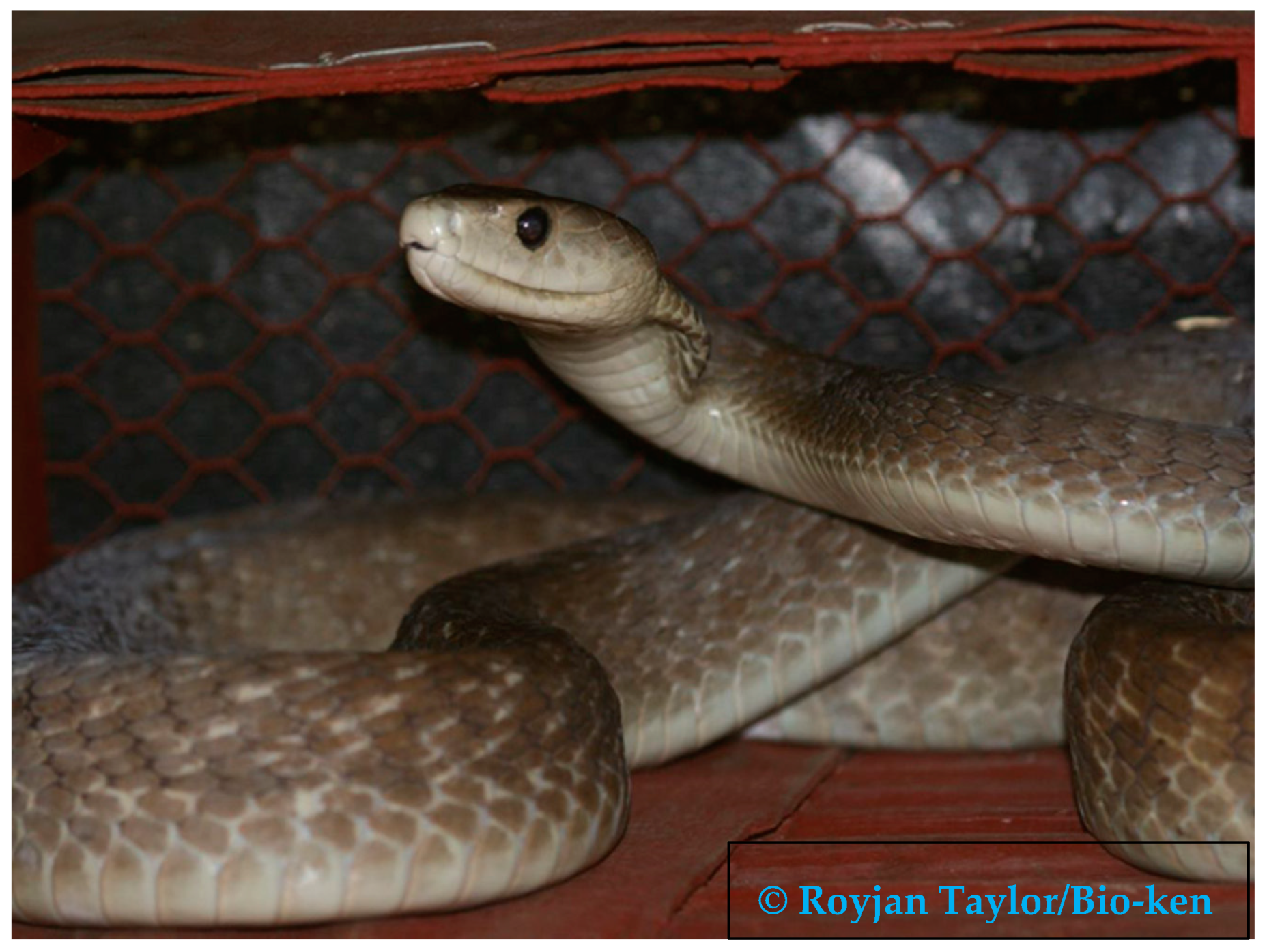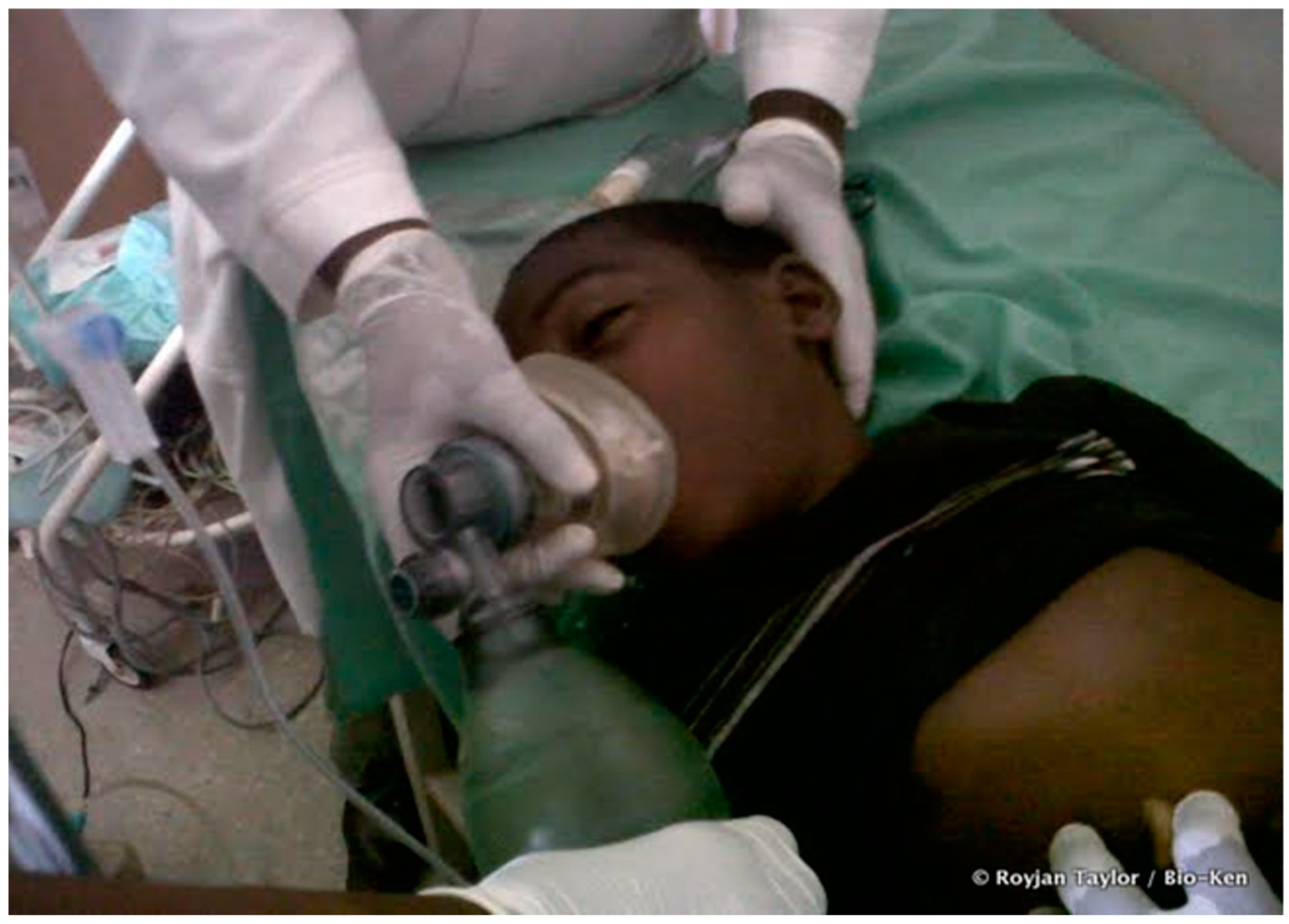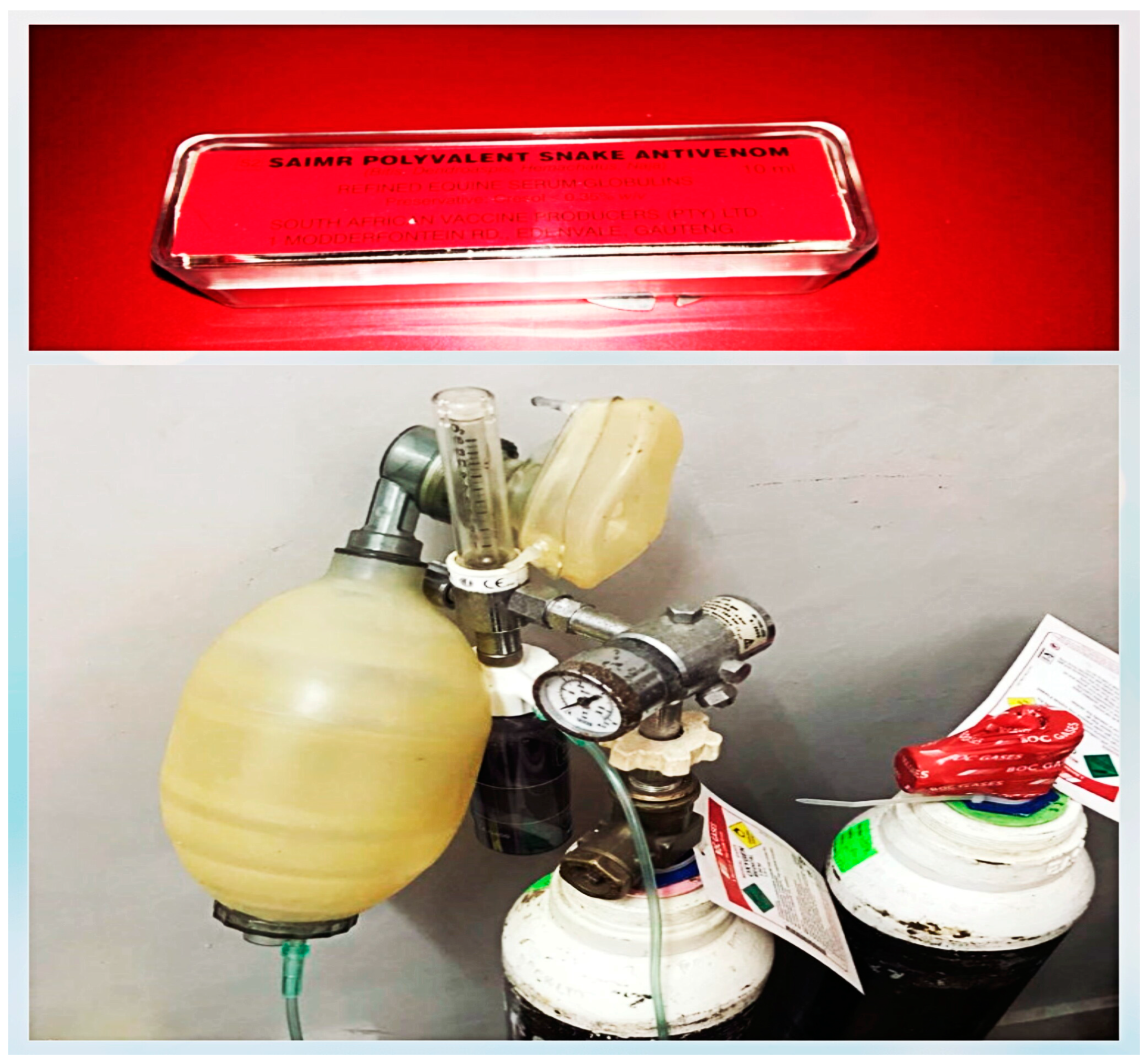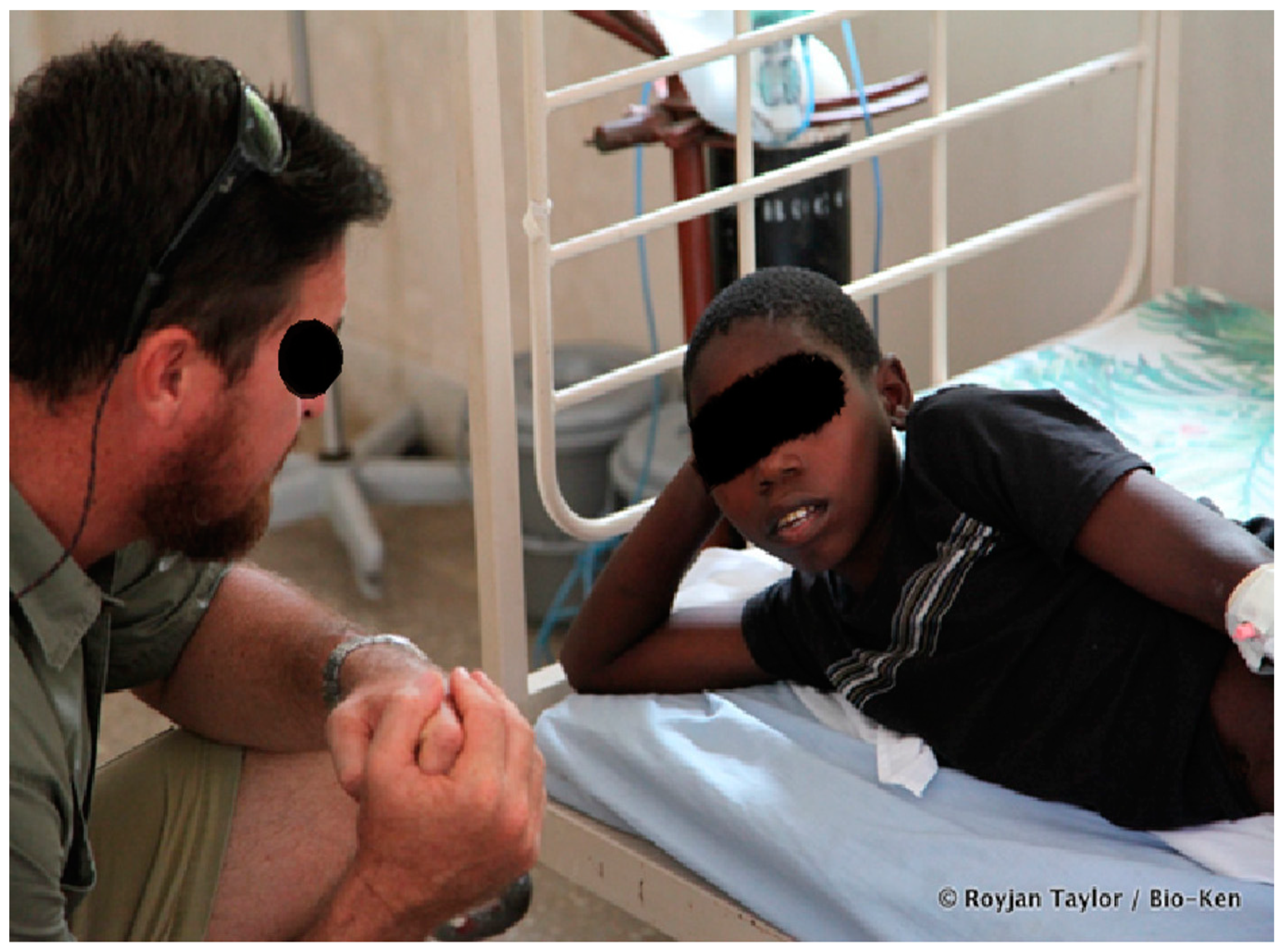Revered but Poorly Understood: A Case Report of Dendroaspis polylepis (Black Mamba) Envenomation in Watamu, Malindi Kenya, and a Review of the Literature
Abstract
:1. Introduction
Background
2. Case Presentation
3. Discussion
Author Contributions
Funding
Acknowledgments
Conflicts of Interest
Consent for Publication
References
- Hodgson, P.S.; Davidson, T.M. Biology and treatment of the mamba snakebite. Wilderness Environ. Med. 1996, 7, 133–145. [Google Scholar] [CrossRef] [Green Version]
- ITIS Standard Report Page: Dendroaspis. Available online: https://www.itis.gov/servlet/SingleRpt/SingleRpt?search_topic=TSN&search_value=700211#null (accessed on 25 July 2018).
- World Health Organization (WHO). WHO Guidelines for the Production, Control and Regulation of Snake Antivenom Immunoglobulins; WHO: Geneva, Switzerland, 2018. [Google Scholar]
- Laustsen, A.H.; Lomonte, B.; Lohse, B.; Fernández, J.; Gutiérrez, J.M. Unveiling the nature of black mamba (Dendroaspis polylepis) venom through venomics and antivenom immunoprofiling: Identification of key toxin targets for antivenom development. J. Proteom. 2015, 119, 126–142. [Google Scholar] [CrossRef] [PubMed]
- Harrison, R.A.; Oluoch, G.O.; Ainsworth, S.; Alsolaiss, J.; Bolton, F.; Arias, A.-S.; Gutiérrez, J.-M.; Rowley, P.; Kalya, S.; Ozwara, H. Preclinical antivenom-efficacy testing reveals potentially disturbing deficiencies of snakebite treatment capability in East Africa. PLoS Negl. Trop. Dis. 2017, 11, e0005969. [Google Scholar] [CrossRef] [PubMed]
- Ochola, F.O. Pharmaco-Epidemiological and Toxicological Studies of Snake Envenomations in Selected Areas of Kenya. Available online: http://erepository.uonbi.ac.ke/handle/11295/25888 (accessed on 17 September 2018).
- Quarch, V.; Brander, L.; Cioccari, L. An unexpected case of black mamba (Dendroaspis polylepis) bite in Switzerland. Case Rep. Crit. Care 2017, 2017, 5021924. [Google Scholar] [CrossRef] [PubMed]
- Závada, J.; Valenta, J.; Kopecký, O.; Stach, Z.; Leden, P. Black mamba Dendroaspis polylepis bite: A case report. Prague Med. Rep. 2011, 112, 298–304. [Google Scholar] [PubMed]
- Schutzbach, M.; Vonderhagen, S.; Jäger, M. Antivenom therapy after a black mamba snakebite. Unfallchirurg 2016, 119, 1053–1056. [Google Scholar] [CrossRef] [PubMed]
- Strover, H.M. Report on a death from black mamba bite (Dendroaspis polylepis). Cent. Afr. J. Med. 1967, 13, 185–186. [Google Scholar] [PubMed]
- Saunders, C.R. Report on a black mamba bite of a medical colleague. Cent. Afr. J. Med. 1980, 26, 121–122. [Google Scholar] [PubMed]
- Blaylock, R.S. Snake bites at Triangle hospital: January 1975 to June 1981. Cent. Afr. J. Med. 1982, 28, 1–11. [Google Scholar] [PubMed]
- Crisp, N.G. Black mamba envenomation. S. Afr. Med. J. 1985, 68, 293–294. [Google Scholar] [PubMed]
- Hilllgan, R. Black mamba bites. A report of 2 cases. S. Afr. Med. J. 1987, 72, 220–221. [Google Scholar]
- Naidoo, D.P.; Lockhat, H.S.; Naiker, I.P. Myocardial infarction after probable black mamba envenomation. A case report. S. Afr. Med. J. 1987, 71, 388–389. [Google Scholar] [PubMed]
- Tan, N.H.; Arunmozhiarasi, A.; Ponnudurai, G. A comparative study of the biological properties of Dendroaspis (mamba) snake venoms. Comp. Biochem. Physiol. C. 1991, 99, 463–466. [Google Scholar] [CrossRef]
- Warrell, D.A. Clinical toxicology of snakebite in Africa and the Middle East/Arabian Peninsula. In Handbook of Clinical Toxicology of Animal Venoms and Poisons, 1st ed.; Julian, W., Jurg, M., Eds.; CRC Press: Boca Raton, FL, USA, 1995; pp. 433–492. ISBN 9780849344893. [Google Scholar]
- Silva, A.; Pilapitiya, S.; Siribaddana, S. Acute myocardial infarction following a possible direct intravenous bite of Russells viper (Daboia russelli). BMC Res. Notes 2012, 5, 2–5. [Google Scholar] [CrossRef] [PubMed]
- Wang, C.I.; Reeks, T.; Vetter, I.; Vergara, I.; Kovtun, O.; Lewis, R.J.; Alewood, P.F.; Durek, T. Isolation and structural and pharmacological characterization of α-elapitoxin-Dpp2d, an amidated three-finger toxin from black mamba venom. Biochemistry 2014, 53, 3758–3766. [Google Scholar] [CrossRef] [PubMed]
- Karlsson, E.; Mbugua, P.M.; Rodriguez-Ithurralde, D. Fasciculins, anticholinesterase toxins from the venom of the green mamba Dendroaspis angusticeps. J. Physiol. 1984, 79, 232–240. [Google Scholar]
- de Weille, J.R.; Schweitz, H.; Maes, P.; Tartar, A.; Lazdunski, M. Calciseptine, a peptide isolated from black mamba venom, is a specific blocker of the L-type calcium channel. Proc. Natl. Acad. Sci. USA 1991, 88, 2437–2440. [Google Scholar] [CrossRef] [PubMed]
- Schweitz, H.; Pacaud, P.; Diochot, S.; Moinier, D.; Lazdunski, M. MIT1, a black mamba toxin with a new and highly potent activity on intestinal contraction. FEBS Lett. 1999, 461, 183–188. [Google Scholar] [CrossRef]
- Diochot, S.; Baron, A.; Salinas, M.; Douguet, D.; Scarzello, S.; Dabert-Gay, A.S.; Debayle, D.; Friend, V.; Alloui, A.; Lazdunski, M.; et al. Black mamba venom peptides target acid-sensing ion channels to abolish pain. Nature 2012, 490, 552–555. [Google Scholar] [CrossRef] [PubMed]
- Dufton, M.J.; Harvey, A.L. Dendrotoxins: How does structure determine function? J. Toxicol. Toxin Rev. 1998, 17, 161–182. [Google Scholar] [CrossRef]
- Harvey, A.L.; Robertson, B. Dendrotoxins: Structure-activity relationships and effects on potassium ion channels. Curr. Med. Chem. 2004, 11, 3065–3072. [Google Scholar] [CrossRef] [PubMed]
- Blanchet, G.; Collet, G.; Mourier, G.; Gilles, N.; Fruchart-Gaillard, C.; Marcon, E.; Servent, D. Polypharmacology profiles and phylogenetic analysis of three-finger toxins from mamba venom: Case of aminergic toxins. Biochimie 2014, 103, 109–117. [Google Scholar] [CrossRef] [PubMed]
- Ahmed, S.M.; Ahmed, M.; Nadeem, A.; Mahajan, J.; Choudhary, A.; Pal, J. Emergency treatment of a snake bite: Pearls from literature. J. Emerg. Trauma Shock 2008, 1, 97–105. [Google Scholar] [CrossRef] [PubMed]
- Moran, N.F.; Newman, W.J.; Theakston, R.D.; Warrell, D.A.; Wilkinson, D. High incidence of early anaphylactoid reaction to SAIMR polyvalent snake antivenom. Trans. R. Soc. Trop. Med. Hyg. 1998, 92, 69–70. [Google Scholar] [CrossRef]




© 2018 by the authors. Licensee MDPI, Basel, Switzerland. This article is an open access article distributed under the terms and conditions of the Creative Commons Attribution (CC BY) license (http://creativecommons.org/licenses/by/4.0/).
Share and Cite
Erulu, V.E.; Okumu, M.O.; Ochola, F.O.; Gikunju, J.K. Revered but Poorly Understood: A Case Report of Dendroaspis polylepis (Black Mamba) Envenomation in Watamu, Malindi Kenya, and a Review of the Literature. Trop. Med. Infect. Dis. 2018, 3, 104. https://doi.org/10.3390/tropicalmed3030104
Erulu VE, Okumu MO, Ochola FO, Gikunju JK. Revered but Poorly Understood: A Case Report of Dendroaspis polylepis (Black Mamba) Envenomation in Watamu, Malindi Kenya, and a Review of the Literature. Tropical Medicine and Infectious Disease. 2018; 3(3):104. https://doi.org/10.3390/tropicalmed3030104
Chicago/Turabian StyleErulu, Valentine Eugene, Mitchel Otieno Okumu, Francis Okumu Ochola, and Joseph Kangangi Gikunju. 2018. "Revered but Poorly Understood: A Case Report of Dendroaspis polylepis (Black Mamba) Envenomation in Watamu, Malindi Kenya, and a Review of the Literature" Tropical Medicine and Infectious Disease 3, no. 3: 104. https://doi.org/10.3390/tropicalmed3030104





